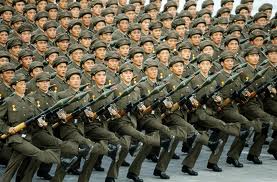It’s important to keep in mind that North Korea isn’t a country in the western sense of the word. It’s a murderous cult. It is the bastard child of the Soviet Union, born in the days following World War II, and succored by China following the Soviets’ collapse. In 2007, a congressional researcher assembled a list of some of Pyongyang’s atrocities dating back to 1950. It’s a bizarre roster of seaborne commandos, international kidnappings, terrorist bombings, poisonings, tunnels and a threat to turn Seoul — a city of 10 million people within range of North Korean guns — into “a sea of fire.” It’s worth noting these kinds of things once in awhile to help us understand the challenges facing the international community in dealing with Pyongyang. Here are some lowlights of North Korean mayhem, one from each of the past six decades, from that congressional accounting:
June, 1950: On June 25, North Korean troops launched a full-scale invasion of South Korea — “an act of aggression” that the United Nations Temporary Commission on Korea determined was “initiated without warning and without provocation, in execution of a carefully prepared plan.” The Korean War ended in July 1953 with an armistice. Total U.S. casualties included 33,629 killed in action and 20,617 killed in non-battle situations for a total of 54,246 deaths, and 103,284 wounded for total U.S. casualties of 157,530. The Republic of Korea suffered 58,127 combat deaths and 175,743 wounded. Other countries under the United Nations Command had an estimated 2,800 killed and 10,783 wounded. Neither China nor North Korea has released numbers for their casualties, but they are estimated at 900,000 for China and 520,000 for North Korea. In addition, the two Koreas each suffered estimated casualties of one million civilians.
January, 1968: A 31-member commando team, disguised as South Korean soldiers and civilians, infiltrated within striking distance of President Park Chung Hee’s office/residence complex (The Blue House) before they were intercepted by South Korean police; 29 commandos were killed and one committed suicide; one who was captured revealed that their mission was to kill President Park and other senior government officials. Two South Korean policemen and five civilians were killed by North Korean infiltrators.
August, 1976: A group of North Korean soldiers, wielding axes and metal pikes, attacked a U.S.-South Korean tree-trimming work team in a neutral area inside the DMZ at Panmunjom, killing 2 U.S. army officers and wounding 4 American enlisted men and 5 South Korean soldiers. In a message to UN Commander General Richard G. Stillwell, North Korea’s Kim Il Sung described the incident as “regrettable,” without admitting North Korean responsibility for what the U.S. government condemned as a “vicious and unprovoked murder” of the officers.
October, 1983: The explosion of a powerful bomb, several minutes before South Korean President Chun was to arrive to lay a wreath at the Martyr’s Mausoleum in Rangoon, Burma (Myanmar), killed 17 senior South Korean officials and injured 14 who were accompanying President Chun, then on the first leg of a six-nation Asian tour. Among the killed were: presidential chief-of-staff and another senior presidential assistant; deputy prime minister/minister of economic planning; three cabinet members including foreign minister; 3 deputy ministers; and the South Korean ambassador to Burma. The explosion also killed four Burmese nationals and wounded 32 others. President Chun stated that the killings were “a grave provocation not unlike a declaration of war,” and warned the North that “should such a provocation recur, there would be a corresponding retaliation in kind.” North Korean leader Kim Il Sung dismissed Chun’s statement as “a preposterous slander.” Two suspects were arrested and tried in the Rangoon Divisional Court: North Korean army major, Zin Mo, and captain, Kang Min Chol. Captain Kang Min Chol confessed to the bombing and gave details of his training in North Korea and transport to Burma on a North Korean freighter. He also disclosed that after the arrival of his assassination team in Burma, the team stayed in the home of a North Korean embassy councilor. On November 4, Burma broke off diplomatic relations with North Korea. In February 1984, the Burmese Supreme Court sustained the death penalty handed down by the lower court.
March, 1997: Japan’s daily newspaper Sankei Shimbun, based on an interview with a former North Korean agent An Myong-chin (who defected to South Korea in September 1993), reported that in November 1977, Megumi Yokota, a 13-year-old Japanese school girl was abducted in Niigata City and taken to North Korea for use as a teaching aide at a North Korean school for spy training. Japanese authorities disclosed that An’s description of the girl matched the profile of a girl reported missing in Niigata, Japan, at that time. Japanese authorities suspect that North Korea may have kidnaped at least nine other Japanese nationals since the mid-1970s.
September, 2004: Sources in Seoul and Beijing report seeing a huge mushroom cloud in northern North Korea on September 9, the anniversary of the founding of the DPRK. President Bush reportedly is briefed that the cloud may have resulted from a nuclear test. North Korea claims the cloud resulted from a detonation associated with a hydroelectric dam, but when it transports foreign ambassadors to the area for a visual inspection, it brings them to a site 60 miles away from where the cloud was reported. South Korean authorities later say the episode may have been an unusual cloud formation.



